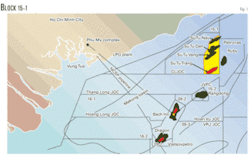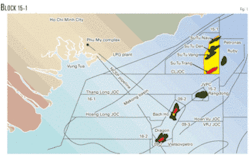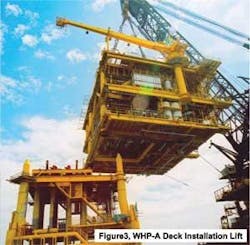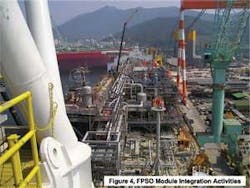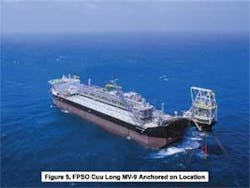Following the Su Tu Den discovery in Block 15-1 off Vietnam, a fast-track field development program culminated in first oil production only 2 years and 82 days after declaration of the field’s commerciality.
This goal was achieved with an excellent safety record of no lost time accidents in more than 3.6 million man-hr of exposure.
The Cuu Long Joint Operating Co, (CLJOC) was awarded Block 15-1 in late 1998. CLJOC began aggressive exploration that resulted in the first exploration well discovering Su Tu Den (Black Lion) field in October 2000.
Block 15-1
The Cuu Long Joint Operating Co. was established on Oct. 28, 1998, for the purpose of operating Block 15-1. The coventurers include PetroVietnam Exploration & Production, 50%; ConocoPhillips (UK) Cuu Long Ltd., 23.25%; Korea National Oil Corp., 14.25%; SK Energy, 9%; and Geopetrol SA, 3.5%.
Block 15-1 is at the north end of the Cuu Long basin, about 180 km east-southeast of Ho Chi Minh City (Fig. 1). Water depth ranges from 35 to 60 m.
The initial exploration area encompassed about 4,600 sq km. Three relinquishments during the exploration program reduced the area to the 807 sq km held as production acreage.
Producible hydrocarbons in Block 15-1 are in the fractured granite basement, B-10 Miocene and C-30 Oligocene clastic zones. Each horizon contains sweet, medium gravity, high paraffin, low-sulfur crude that commands a premium price to the regional benchmark.
The fractured granite basement contains the majority of the recoverable reserves and is the primary productive horizon. The basement reservoir complexity and the wide range of uncertainty about reserves were key elements in the risk-based development planning process.
CLJOC spudded the first well, 15-1-SD-1X, on the Su Tu Den (Black Lion) prospect on Aug. 6, 2000, and completed it as a discovery on Oct. 6, 2000. Well 15-1-SD-2X/ST established minimum economic reserves, allowing the Su Tu Den Southwest field area to be declared commercial on Aug. 8, 2001.
Development concept
A brief conceptual engineering study from July through October 2001 defined the project’s design basis and scope. The optimum field development plan used a risk-based approach. The complexity of the basement reservoir, reserves uncertainty in Su Tu Den Southwest field, and the overall potential of Block 15-1 led to a development plan consisting of a floating production, storage, and offtake (FPSO) vessel and a wellhead platform.
In addition to reservoir complexity, reserves uncertainty, and block potential, the following points figured prominently in development configuration decision:
- Perception that an FPSO project could be brought on stream faster than a conventional field development.
- The belief that an FPSO could be configured with flexibility for future expansion more readily than a jacket-based facility.
- A lease-purchase contract strategy for the FPSO could be structured partially to mitigate downside impact of poor reservoir performance while preserving the upside in the event that additional discoveries were made. If the reservoir failed to perform, the FPSO lease could be terminated. If further exploration was successful, then the FPSO could be used in an expanded development.
Preliminary engineering
CLJOC conducted preliminary engineering in two parts between November 2001 and mid-March 2002. A design competition was held among three qualified FPSO general contractors with the objective of developing a preliminary design while simultaneously preparing a bid for the FPSO scope of supply. The scope of this contract included the FPSO, turret, moorings, and flexible risers.
The FPSO was specified as a permanently moored double-sided SuezMax class tanker equipped with an external turret. The topsides facility design capacity was set at 65,000 bo/d, 75,000 b/d of injection water, 130,000 b/d of produced water, and 30 MMscfd of lift gas compression. Useful vessel storage capacity was 980,000 bbl of oil.
Parallel to the FPSO design competition, CLJOC performed preliminary engineering to define further the wellhead platform, with focus on jacket design. The objective was to define the deck configuration and weight and complete a detailed jacket design in time to fabricate and install the jacket before the weather window closed in late 2002.
While CLJOC recognized that this approach could result in a suboptimum jacket design due to poor definition of the deck, the benefits of early jacket installation far outweighed any savings from design optimization. Early jacket installation allowed predrilling six wells in a dry-tree configuration prior to deck installation. However, tree guards were required, and extra caution was needed during deck installation to prevent damaging the wellheads.
The wellhead platform, WHP-A, is a 24 slot-28 well, four-pile, 890-tonne jacket with a 2,000-tonne deck equipped with production, test, lift gas, and injection water manifolds, two-phase production and test separators, and a flare system. Power is supplied by an umbilical from the FPSO.
Four pipelines link WHP-A to the FPSO. These are a 14-in. produced liquid, a 14-in. low-pressure gas, an 8-in. lift gas, and a 12-in. water injection line.
Contracting strategy
The CLJOC management committee and coventurer companies sanctioned Su Tu Den field development in early March 2002. The CLJOC project team was tasked with the following goals:
- Executing and delivering the project safely with no company and contractor lost-workday cases.
- Achieving a first-oil target date of Apr. 15, 2004, with a stretch goal of Nov. 6, 2003.
- Designing the facility to ramp-up to full capacity within 90 days of first oil.
- Adhering to the project budget, ±10%.
- Achieving long-term average direct operating efficiency of at least 92%.
CLJOC developed a fit-for-purpose contracting strategy designed to achieve the project goals in the most efficient way possible. This strategy utilized multiple contracts with several contractors across the globe. Fig. 2 shows the relationship among CLJOC, the prime contractors, and each subcontractor.
WHP-A jacket
As stated, CLJOC performed preliminary engineering with the objective of designing, fabricating, and installing the WHP-A jacket before the 2002 weather window closed. CLJOC used KBR in Houston for the initial design work, along with internal CLJOC staff to procure and free-issue materials to the jacket’s fabrication contractor.
CLJOC selected VietSovPetro (VSP) of Vung Tau, Vietnam, as that fabrication contractor, based on its expertise in fabricating small jackets and its ability to bring local content to the project.
VSP subcontracted jacket installation to McDermott International. The fabricator cut first steel on May 2, 2002, and McDermott completed installation of the jacket on Sept. 8, well before the 2002 weather window closed.
WHP-A deck, pipelines
CLJOC awarded the WHP-A deck and pipelines engineering, procurement, construction, and installation (EPCI) contract to Petroleum Technical Services Corp. (PTSC). PTSC in-turn nominated KBR to perform detailed engineering. KBR began work in Houston and moved the job to Singapore in August 2002.
CLJOC discipline engineers split their time between the FPSO topsides and WHP-A deck detailed engineering offices before the move to Singapore.
The PTSC-McDermott alliance based at Vung Tau performed procurement and fabrication, and McDermott served as installation contractor for the deck and pipelines.
Deck fabrication began at the PTSC Vung Tau yard in October 2002. The deck sailed in late September 2003 with installation completed a few weeks later on Oct. 2.
The deck was mechanically complete at sail-away, and most precommissioning activities were closed out.
Fig. 3 shows the WHP-A Deck installation lift in progress.
FPSO topsides
CLJOC selected MODEC Inc. of Tokyo as prime contractor for the FPSO EPCI contract. MODEC selected Alliance Wood Group Engineering (AWGE) of Houston as the FPSO topsides module detailed engineering subcontractor. For fabricator of both the FPSO hull and topsides modules, MODEC nominated Samsung Heavy Industries (SHI) of Geoje, South Korea.
FMC-SOFEC of Houston received the turret EPCI contract and subcontracted the turret fabrication to Malaysia Shipyard and Engineering at Johor Baru, Malaysia. McDermott International acted as FPSO installation contractor.
MODEC mobilized a project team to the AWGE project office in Houston where they resided until January 2003. Work at AWGE began in late March 2002 and continued through April 2003. CLJOC maintained a significant oversight presence in the design office to ensure the FPSO topsides design met specifications. AWGE also provided procurement support to MODEC for major equipment and selected bulk items used in the topsides modules.
The FPSO topsides includes six modules plus the motor control center (MCC)-switchgear building and lease automatic custody transfer (LACT) unit. The topsides module total weight exceeds 4,100 tonnes.
The project procured equipment worldwide. Production separators, scrubbers, and the glycol dehydration system were fabricated in South Korea, and the MCC-switchgear building was sourced from Japan. The balance of the major equipment, including gas compression, power generation, seawater and produced-water treating systems, and the control system were supplied by US manufacturers.
Procurement became a significant problem in Autumn 2002 when a labor dispute on the US West Coast halted shipments from the Port of Los Angeles. The situation arose just as major equipment deliveries started. Rerouting many of the packages through the Port of Houston and transporting them to South Korea on a dedicated cargo ship resolved this problem.
Consequently, all equipment arrived at the shipyard in time for integration into modules without disrupting the module’s fabrication schedule.
FPSO hull, module fabrication
Theh initial FPSO bid was based on using a refurbished tanker hull; however, this approach could not meet the desired project schedule. During the bidding process, Samsung Heavy Industries offered the prime contractor a shipyard slot to fabricate a new-build hull, greatly reducing the schedule risk. Fabricating the hull and topsides modules at the same location eliminated the need for multiple module lifts, seaborne transport, and allowed the project to use the time better than if it had to dedicate time for module transportation.
The decision to pursue a newbuild hull greatly reduced the risk of scope, schedule, and cost growth associated with refurbishing an existing vessel and was a key for ensuring project success.
CLJOC personnel arrived at the SHI Geoje yard in September 2002. SHI held the FPSO hull steel cutting ceremony on Oct. 4, 2002, after which construction began on the major hull sections. The yard laid the keel on Mar. 10, 2003, and the hull left dry-dock on May 3, 2003.
Topsides module steel cutting started on Dec. 20, 2002. Following turret integration, SHI set the process modules and the MCC-switchgear building on the deck in late-April to early-June 2003. Module integration and mechanical completion activities progressed throughout the summer and into September 2003. Fig. 4 shows the module integration activities in summer 2003 as seen from the turret’s support structure looking aft.
The greatest challenge associated with the contracting strategy was the number of worksites and the management of communications between them. At peak load in late 2002, the project had six sites operating worldwide. These included FPSO topsides engineering in Houston, turret fabrication in Malaysia, FPSO hull fabrication in South Korea, WHP deck engineering in Singapore, WHP deck fabrication in Vung Tau, and the CLJOC project management office in Ho Chi Minh City.
Finally, the ship was christened as the FPSO Cuu Long MV-9 on Sept. 8, 2003.
Typhoon Maemi
Even after the project team overcame the fast-track schedule, operating multiple sites worldwide, and labor disruptions to equipment procurement, nature dealt the project team one final hurdle.
Typhoon Maemi, one of the largest storms to hit the region in recent history, passed directly over Geoje Island on Sept. 13, 2003. The storm damaged many vessels, but the FPSO Cuu Long MV-9 remained relatively unscathed and sailed away from the shipyard as planned on Sept. 28, 2003.
Project safety
Excellent safety performance was the most important objective achieved by the project.
CLJOC, its contractors, and subcontractors expended more than 3.6 million man-hr between Mar. 20, 2002, and Oct. 29, 2003, on the project. The project did not incur a single lost-time accident and only had six recordable incidents, thus achieving the primary project goal.
This achievement was possible only with the relentless commitment to safety by CLJOC, MODEC, their respective subcontractors, and the individual workers who made the job a success.
Project execution, operations
The FPSO arrived at Su Tu Den field on Oct. 13, 2003. Installation and hookup activities progressed as planned and first oil flowed on Oct. 29, 2003, 6 months ahead of the sanction schedule and 8 days ahead of the stretch goal of Nov. 6, 2003. Fig. 5 shows the Cuu Long MV-9 anchored in Su Tu Den field.
Production reached facility capacity 22 days after first oil and consistently equaled or exceeded facility capacity 42 days after first oil, thus achieving the goal of ramping up production in the first 90 days of operation.
The total final project cost (excluding the FPSO lease cost) exceeded the authorized budget by 4.4%, well within the 10% overrun band. This result was considered a success.
Direct operating efficiency for Su Tu Den field, tracked since April 2004, has consistently exceeded the 92% target.
Lessons learned
Despite their general reputation for providing fast-track developments, FPSOs are notorious for schedule delays and cost overruns. In a study by a prominent benchmarking organization,1 less than a third of FPSOs were delivered within budget, only about a quarter met schedule, fewer than a fifth achieved operability requirements, and none achieved all three objectives. The FPSO Cuu Long MV-9 achieved all three targets.
The project had seven key success factors that may apply to other major projects, particularly FPSOs:
1. Newbuild hull decision. The CLJOC project management team clearly understood the benefits and risks associated with the hull decision. On average, there is little schedule and cost benefit for converting an existing tanker hull to FPSO service. A conversion has the potential for significant scope creep, schedule slippage, and cost overruns if the end-user is unfamiliar with the vessel.
In many older vessels, asbestos mitigation can dictate where vessel modification can take place. Fortunately, the newbuild hull option offered during the bid process greatly improved the ability to achieve the project schedule by eliminating uncertainties associated with vessel refurbishment.
2. Common fabrication site, FPSO topside modules and hull. The decision to fabricate the hull and topsides modules at a common location further mitigated schedule risk. This eliminated the need to transport the hull or modules to an integration site, removed risks associated with additional lifting and transportation, and effectively increased the productive work time without extending the project’s schedule. The time that would have been used for module transportation was used for integration and mechanical completion activities.
3. Early jacket installation. Early installation of the WHP-A jacket allowed predrilling six wells in a dry-tree configuration. Consequently, this reduced well costs by eliminating mud-line suspension and tieback costs and risks, and the need for a subsea template. It also eliminated the time, cost, and risk associated with aligning and installing a jacket over a template containing suspended wells. Finally, the dry-tree configuration allowed quick ramp up of production.
4. Common WHP and FPSO design and commissioning resources. CLJOC used a common set of discipline engineers for the WHP-A and FPSO detailed engineering and commissioning activities. Most of the engineering staff were familiar with details of both systems and therefore were able to interact and stand-in for each other with minimal disruption during start-up. This greatly reduced interface problems between the FPSO and WHP.
5. Operations staff integration into the project team. CLJOC operations personnel were seconded into the project team from the start of detailed engineering. They played key roles from design development through commissioning and start-up. The mechanical completion and commissioning process served as a hands-on familiarization and training period for many of the operations personnel.
6. Cross-functional resource assignment. The general contractor based key members of the SHI topsides division in the AWGE design office during topsides module detailed engineering. This allowed SHI to understand better the design and procurement issues and become familiar with AWGE’s design practices and facilitated SHI’s participation in constructability reviews. This also allowed SHI to gain an understanding of procurement-related issues that might affect the schedule.
Similarly, key AWGE personnel were based at the shipyard during module fabrication. This improved communication, eased the transition from detailed engineering to fabrication, and reduced interface problems between the hull and topsides.
7. Having the right people on the project at the right time. A properly staffed project management team is critical to the success of any project. The best solution is to have a group of highly experienced professionals who work together as a cohesive team.
Project success lies with the people; the people make the difference.
Despite the project’s challenges and the general historical performance of FPSO projects, the team delivered a high quality project on budget and ahead of schedule.
Additional approved Block 15-1 projects
CLJOC has two additional oil developments on Block 15-1. Facilities fabrication nearly is complete and installation is under way for the Su Tu Vang (Golden Lion) field.
Detailed engineering and procurement for a second wellhead platform, WHP-B, is in progress. This platform will be installed in the northeast area of Su Tu Den field. The Su Tu Vang facility will supply injection water and lift gas and process produced fluids from WHP-B.
Future potential developments
CLJOC has made two additional discoveries on Block 15-1: Su Tu Trang (White Lion) gas-condensate field, discovered in November 2003, and Su Tu Nau (Brown Lion) oil field, discovered in September 2005.
The Su Tu Trang discovery, at the south end of Block 15-1, is a gas-condensate field with significant potential to play an important role in the domestic Vietnamese gas market. The field currently is under appraisal, various development scenarios are under study, but commerciality has yet to be established.
Su Tu Nau field, at the north end of Block 15-1, contains a low GOR medium-gravity oil. The field is currently under appraisal, and commerciality has yet to be established.
Acknowledgments
The authors thank the management of the Cuu Long Joint Operating Co., PetroVietnam, PetroVietnam Exploration & Production, ConocoPhillips (UK) Cuu Long Ltd., Korea National Oil Corp., SK Energy, and Geopetrol SA for permission to publish this article.
Reference
- FPSO Best Practices, Upstream Industry Benchmarking Conference, Independent Project Analysis, Nov. 11, 2003.
The authors
C.A. Robertson (carl.a. [email protected]) served as topside engineering manager for Su Tu Den field development. He is seconded to the Cuu Long joint operating company by ConocoPhillips, with responsibility for concept selection and economic analysis of new developments in Block 15-1. Robertson began his career in 1988 with ARCO Oil & Gas Co., Plano, Tex., and joined Conoco in 1990. He holds BS and MS degrees in chemical engineering from Oklahoma State University and is a registered professional chemical engineer in Oklahoma and Alaska.
Duong Thanh Liem ([email protected]) is seconded by PetroVietnam Exploration & Production to the Cuu Long joint operating company as chief economic analyst and deputy project manager for the Su Tu Trang field development. Liem joined CLJOC in May 2002. He joined PetroVietnam E&P in 1993. He received a diploma (1991) of geological engineering from the Polytechnic University of Ho Chi Minh City and a diploma of international development (option logistics; 1996) from Bioforce Development Rhone-Alpes in France. In 2001, Liem received a master of science in petroleum economics from the Institut Francais du Petrole at Rueil Malmaison, France.
Cuu Xuan Bao is seconded by PetroVietnam as development manager to the Cuu Long joint operating company in Ho Chi Minh City. Before assuming his current role, Bao served as deputy development manager and deputy operations manager in CLJOC. Bao held the position of senior petroleum engineer with PetroVietnam before his assignment with CLJOC. Bao holds a PhD in petroleum engineering from the Institute of Petroleum and Chemistry at Baku.
C.J. Wall was project manager for Su Tu Den field development. He is seconded as deputy development manager to the Cuu Long joint operating company by ConocoPhillips with project management responsibility for additional developments on Block 15-1. He is also a major project manager with ConocoPhillips. Wall began his career in 1972 with Conoco (U.K.) Ltd.
